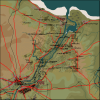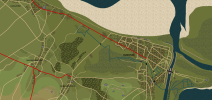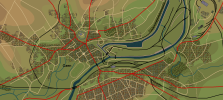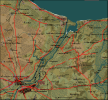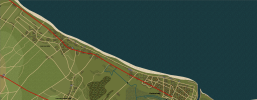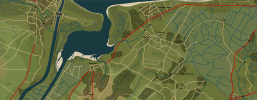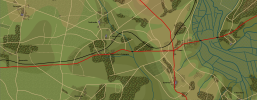I've come to the conclusion that a purely historic scenario is just about impossible. Either I start from the very beginning D Company's coup-de-main at 00:16h or I let it start from the point that all of the five Eastern bridges are destroyed, which is at 15:00h.
I like the first option as it will be the most engaging, giving you the whole operation to play out for yourself. The disadvantage is that the Eastern bridges would need to be "guarded" with the deny crossing order. As said before, this did not happen in real life. The assigned battalions just blew them up and retreated to towards the division to take up better defensive positions. So, in game terms, you'd have to put the deny crossing objectives at each of the bridges and indeed let the airborne troops have some engineering value. I'm willing to give this a try as I think it might actually make for a quite challenging scenario.
The second option would allow me to make the scenario purely historical. The last bridge, the one at Troarn was blown at 15:00h. But letting the scenario start at 15:00h will obviously cut out some of the action. This is why I don't really like this option. Also I'm not sure of the positions of all of the units by that time. The Allies' positions are still quite well documented, but the Axis' positions are quite difficult to figure out. So either way I'd have to make some guesses and this would also make it not that historically correct.
How do you guys see this?
You're falling into the trap of attempting to make the scenario replicate history.
The scenario should adhere to history for the start, and then let the player address the issues that the commander(s) faced as it progresses from that point. It means that the same resources, and goals are in place at start, but the commander on the ground has the latitude to use those resources to address the goals as he sees fit.
As the air landing unfolded, the Axis had no idea how important the five bridges were to its defenses. Keep in mind, that for the first few hours of the invasion, particularly during the airborne phase, the Axis believed the attack was a diversion to draw troops from Pas-de-Calais, where the Axis commanders believed the main allied invasion was aimed. Between the confusion of identifying where the airborne units were sited, and the belief that troops were needed to defend beaches to the north, the Axis response to the air drops was weak and uncoordinated during the first period of the scenario.
In terms of Axis AI, you can replicate the confusion over taking action with unit health attributes that make the Axis less aggressive. You can also address it by defining making the bridges less important for the Axis AI to defend than for the Allied AI (or human commander) to take and destroy.
If I were to create Axis goals, they would revolve more around destroying a nuisance in the rear area rather than holding ground tactical advantages in the region. Any hard objectives would be derived from the need to isolate the landing forces, and compress them into an area where they could be destroyed in detail.
In the case of the Allies, who were privy to the strategic plan, the goals should be taking objectives and holding them until the bulk of the invasion forces arrive.
